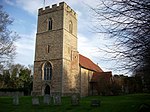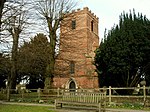Elsenham railway station

Elsenham railway station is found on the West Anglia Main Line, serving the village of Elsenham in Essex, England. It is 35 miles 45 chains (57.2 km) down the line from London Liverpool Street, and is situated between Stansted Mountfitchet and Newport stations. Its three-letter station code is ESM. The station and all trains serving it are operated by Greater Anglia. The ticket office (on the London-bound platform) is staffed part-time; there are self-service ticket machines on each of the platforms (which are staggered, the country-bound being north of a level crossing and the London-bound being south of it) and a permit to travel machine is also available. Electronic real-time departure boards are available on both platforms.
Excerpt from the Wikipedia article Elsenham railway station (License: CC BY-SA 3.0, Authors, Images).Elsenham railway station
Old Mead Road, Uttlesford Elsenham
Geographical coordinates (GPS) Address Nearby Places Show on map
Geographical coordinates (GPS)
| Latitude | Longitude |
|---|---|
| N 51.921 ° | E 0.228 ° |
Address
Elsenham Rail Car Park
Old Mead Road
CM22 6UE Uttlesford, Elsenham
England, United Kingdom
Open on Google Maps









